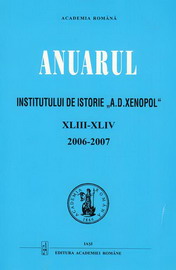Formaţiunile „minore“ de rezistenţă anticomunistă din Banat (1947/1948 – începutul anilor ’60)
"Minor" Groups of Anticommunist Resistance in Banat. 1947/1948 - beginning of the 1960'
Author(s): Dorin DobrincuSubject(s): History
Published by: Editura Academiei Române
Keywords: anticommunist fighters; anticommunist resistance
Summary/Abstract: If some of the anticommunist resistance groups in Banat – those led by colonel Ion Uţă, lawyer Spiru Blănaru, commander Petru Domăşneanu, notary public Gheorghe Ionescu, private clerk Ion Tănase, lawyer Ion Târziu and engineer Aurel Vernichescu – entered the historiographic circuit and public conscience, we know very few things about others. These “minor” groups (we understand by that their lack of visibility, the small number of members and often their brief existence) played however a part in maintaining the criticizing spirit against the communist authorities during the second half of the 1940s to the beginning of the 1960s. The recording of all these groups helps us better understand the real dimensions of the anticommunist resistance in Banat. Some of these resistance groups had specific names (“King Mihai’s Partisans” or major Radu Coman’s group, “National Battalions of Partisans”, the organization “Mihai’s Sword”, the organization “Romanian Partisans”), while others were named after their leaders (Blaj brothers organization, Sidociuc subversive organization or the “illegal newspaper România Mare”, dr. Petre Ambrus group, Moise Roi group, colonel Ştefan Popescu group, Avram Matu group, Gheorghe Ivanici group, Valeriu Achim group, Nicolae Creţu group, Vasile Duma’s organization, Emilian Strian group, Ioan Seleşan group) or after the origin localities of most of the members (the group of Duleu, the group of Rugi, the anticommunist organization of Rusca, the peasant organization of Mercina village), while others had no name or we do not know their real names (the collegiate resistance organization in Timişoara). Between some of these groups there existed relationships, even though temporary ones, through their members. The fact that some of the anticommunist partisans joined several of the reminded groups underlines the big fluctuation that existed in the resistance movement in Banat, but also the difficulty to reconstruct with high fidelity the composition of these groups. There also existed isolated anticommunist fighters, who had sometimes contacts with the resistance groups, but who preferred to act alone. Such a case was Ion Banda, the last active anticommunist fighter in Banat, but also in Romania.
Journal: Anuarul Institutului de Istorie »A.D. Xenopol« - Iaşi
- Issue Year: 2006
- Issue No: 43+44
- Page Range: 549-572
- Page Count: 24
- Language: Romanian

